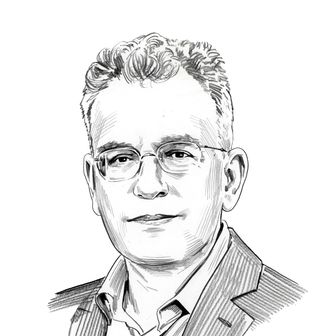
By the half-meaningful measure of longevity, Al Jaffee was peerless. MAD magazine, founded in 1952, published 550 issues plus a handful more after a reboot in 2019, and fresh work by Jaffee appeared in 509 of them. He got to MAD in 1955 and stepped away in 2020, not terribly long before his death this Monday, April 10, at 102. But the length of his run barely touches upon his skill, accessible wit, and ability to channel the collective ethos of the Usual Gang of Idiots while also producing work that was all Al.
Consider “Snappy Answers to Stupid Questions,” his recurring column with a baby-simple premise: A character asks a particularly S.Q., and another character responds with three snarky S.A.’s. It was Groucho Marxism for beginners, an instruction manual for budding teen smart-asses entering the world of dopey adults. It no doubt was the bane of all but the most enlightened parents and teachers. A Jaffee-drawn guy might walk up to a crumpled automobile and ask, “Have an accident?” The replies would include “No, I’m starting a junk yard!” and “No, I’m a modern sculptor,” as well as a blank speech bubble where you could write in your own. Spend time with a selection of “Snappy Answers to Stupid Questions” as an adult, and you’re likely to simultaneously say “This is kind of dumb” and laugh your head off. That was MAD in its prime: a magazine specializing in irreverence during an era that, at least in the mainstream, was mostly reverent.
“Snappy Answers” often addressed pet peeves, and that instinct pervades Jaffee’s work, especially another long-running series devoted to absurd inventions. Except that they weren’t patently (so to speak) absurd: Most slid right up to the edge of funny practicality, like a giant-size toilet-paper holder that housed ten replacement rolls, or a “hot hand” handbag that contained heating coils activated by a breakaway handle, intended to scorch purse-snatchers. (Why not?) Perhaps inevitably, a number of those inventions have crossed the line from plausible product to actual one, including plastic-cup lids with built-in straws and cartridge razors with a comical number of blades. Quite a few of the rest are infomercial-ready. (A sound-generating machine for bathrooms to obscure toilet noises during parties? But wait! There’s more!)
Another thing about MAD — one that I particularly admire as an editor myself — was that its makers knew that young people, especially, used to dive into magazines in a unique way. Adults typically read them and tossed them, but kids tended to hang onto them as physical objects they bought with their sparse allowances. They would (and I would) read and reread and re-reread them, slowly discovering tertiary and quaternary strata within as the covers grew loose and fell off. MAD was happy to provide details for them to discover as they bored in, from jokes hidden in the corners of its panels in six-point type to Sergio Aragonés’s “Marginals,” the tiny images sprinkled around the edges throughout each issue. They were Easter eggs before we had that term.
Jaffee did not have that kind of childhood. He grew up weirdly and under stress, in a life that did not follow a familiar Jewish American–immigrant path. He was born in Savannah, Georgia, and his mother moved to a harsh Lithuanian shtetl when he was 6. Then he returned to America (to live with his father), then went back to Lithuania (with his mother again), and finally, as the Nazis swept in, fled to New York as a teenager. It was an unstable and chaotic youth. You have to assume that someone who came from that world and then landed in the High School of Music & Art, amid eccentric artsy city kids of all kinds, would develop an off-kilter worldview, one that might be described as inside-out.
Which brings us to the “Fold-In.”
Bill Gaines, the founder of MAD and its publisher for its first 40 years, used to say that teenage boys read his magazine till they graduated to Playboy, then came back to MAD once they’d grown up. Jaffee, for his part, said he was (slightly) thinking of Playboy’s centerfold and the other big expensive gatefolds that mass-market magazines used to run. “It’s almost as if there’s a little buzzer in my head that goes off,” he told his biographer, Mary-Lou Weisman. “The buzzer says, ‘How about a foldout-foldout-foldout, one that goes on for twelve feet?’” And, when that was impractical: “If I can’t do foldouts, how about fold-ins? MAD could do a cheesy black-and-white fold-in.” The double image — one basic and then a second revealed by creasing the page twice, causing its extreme left and right edges to mesh — was tricky to conceive and trickier to render, and nobody else but Jaffee ever quite got the knack. Like the “Snappy Answers” column, it incorporated a question-and-response. It does something highly unusual in a print magazine: It moves and changes, straining the limits of a pulp-paper product to produce a rudimentary animated gag. It is, I’d argue, an early gesture in the direction of the joke GIF.
Each took him a couple of weeks. The first one appeared in 1964 — the feature went from black-and-white to color (which he found more difficult to render) a few years later — and the last one ran in 2020. Jaffee told Weisman he “sweated” the first couple of hundred. It became such an institution that Jaffee filed one to MAD that was intended to run as his obituary — and then he more or less outlived the magazine, which no longer publishes original content. Instead, the editors ran it to mark his 99th birthday in 2020.
And what is the hidden message of that final “Fold-In”? “Why is the ‘What, Me Worry?’ kid so worried?” the text asks up top, above a row of factories and other businesses whose signs indicate their imminent closure. Smokestacks emit white plumes behind the words “ECONOMY COLLAPSING! UNEMPLOYED STARVING!” But fold it together and the new message appears: a puffy white caricature of Jaffee himself, above the words “NO MORE NEW JAFFEE FOLD-INS.” He used his exit to make fun of any importance attached to his work; the institution for which he wrote; and you, the reader who cared about this stuff. A very snappy, and pretty un-stupid, final answer.



